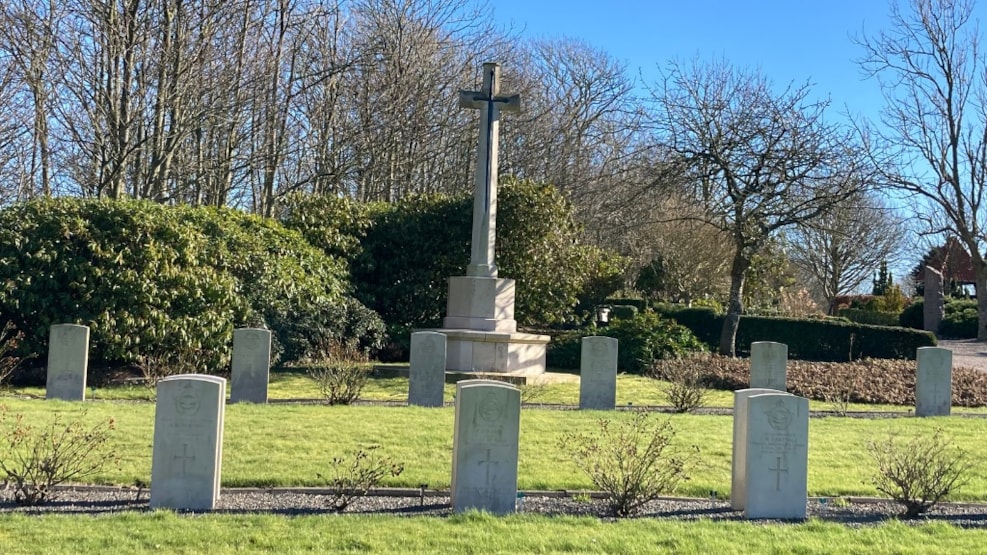
Lemvig Cemetery - Commonwealth War Graves
A walk around the cemetery is rich in cultural history. Grave monuments and parks bear witness to different ways of remembering and honoring loved ones through the ages.
The memorial groves for those who never came home from the sea, fallen soldiers on both sides of World War II and refugees give rise to quiet contemplation.
By 1809, the town of Lemvig had grown so much that it was not possible to expand the cemetery. It was therefore moved up to the end of Vesterbjerg, which at the time was outside the town.
The original cemetery was converted into a square, which today surrounds Lemvig Church.
Torvald and Ejgil Westergaard
Many of the tombstones and memorials in the cemetery were made by the two stonemasons and sculptors Torvald Westergaard (1901-1988) and his son Ejgil Westergaard (1928-2015), who worked to unite arts and crafts mainly in granite.
You can see more works by Torvald Westergaard in the Sculpture Park at Lemvig Museum and along the Sculpture Path. Read more about The Sculpture Path in Lemvig here.
Allied War Graves - Commonwealth War Graves
The small leaflet about Lemvig Cemetery states, among other things:
"During World War II and in the years immediately following, about 120 Allied and German soldiers and German refugees were buried around the cemetery.
"Immediately after the end of the war, they were gathered in the two memorial groves next to each other for Allied and German soldiers, respectively."
In the first years of the occupation, slain British pilots were buried near German military bases. Killed pilots who drift ashore on the coast were buried at the nearest cemetery. From 1942, the number of crashes increased and the Germans decided to establish five cemeteries, central cemeteries, which received killed pilots from certain areas - including Lemvig Cemetery. From May 17, 1941 to December 1943, 42 British, 1 Polish and 6 American pilots were buried here. The American pilots were repatriated to the United States in May 1948.
After the war, local citizens in Lemvig took the initiative to establish a memorial grove for the buried Allied pilots. Relocation and attempts to identify the unknown took place in July 1948. British authorities borne the cost of relocating the graves as well as the headstones and the Cross of Sacrifice. The cost of the memorial grove was borne by local church and municipal authorities. In the 1950s, all burial sites were provided with new tombstones of Portland granite (sandstone) and the large cross erected.
Of those buried, 9 were unknown unto God. Four of the unknowns were identified in 1998. New tombstones with names were inaugurated at a ceremony on 7 September 1998, where another 1 aviator was found in Ringkøbing Fjord and buried with the name of the tombstone. Families of the identified pilots attended the ceremony with representatives from the R.A.F., the English Embassy, the Home Guard, the Soldiers' Association and the Defense Brothers, as well as church and municipal representatives.
In the memorial grove, every year there is a ceremony with wreath-laying on 4 May and 11 November (All Saints' Day for the Polish aviator), where the Polish Embassy is always represented. Local Soldiers' Associations and the Defense Brothers meet with flags and flag guards and wreaths are laid at the cross. Lemvig City Council is represented by the mayor. Source: Lemvig Cemetery 200 years anniversary
German war graves
Lemvig Cemetery is one of the 34 Danish cemeteries where there are German soldiers' graves from World War II.
In the memorial grove, 63 German soldiers and 17 refugees are buried. The German side wanted to collect the graves in fewer places, so the graves were moved to central locations.
The cost of maintaining the burial sites is paid by the organization Volksbund deutsche Kriegsgräberfürsorge e.V. (National Association for the Care of German War Graves). Read more about the German war graves at Lemvig Cemetery here.